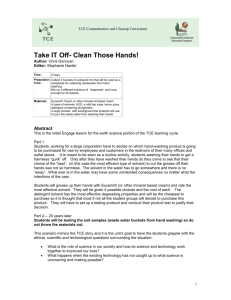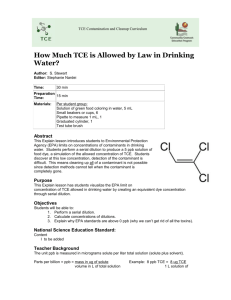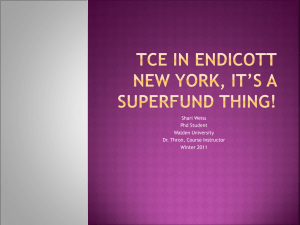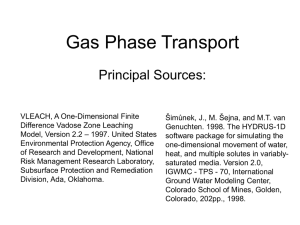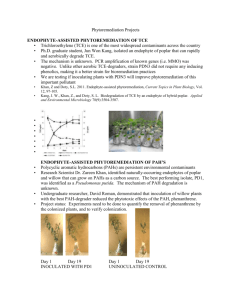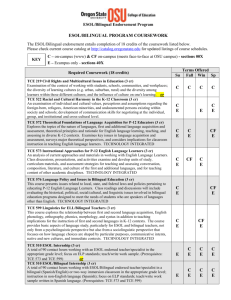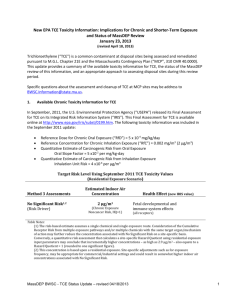Evolving TCE Biodegraders Handout
advertisement
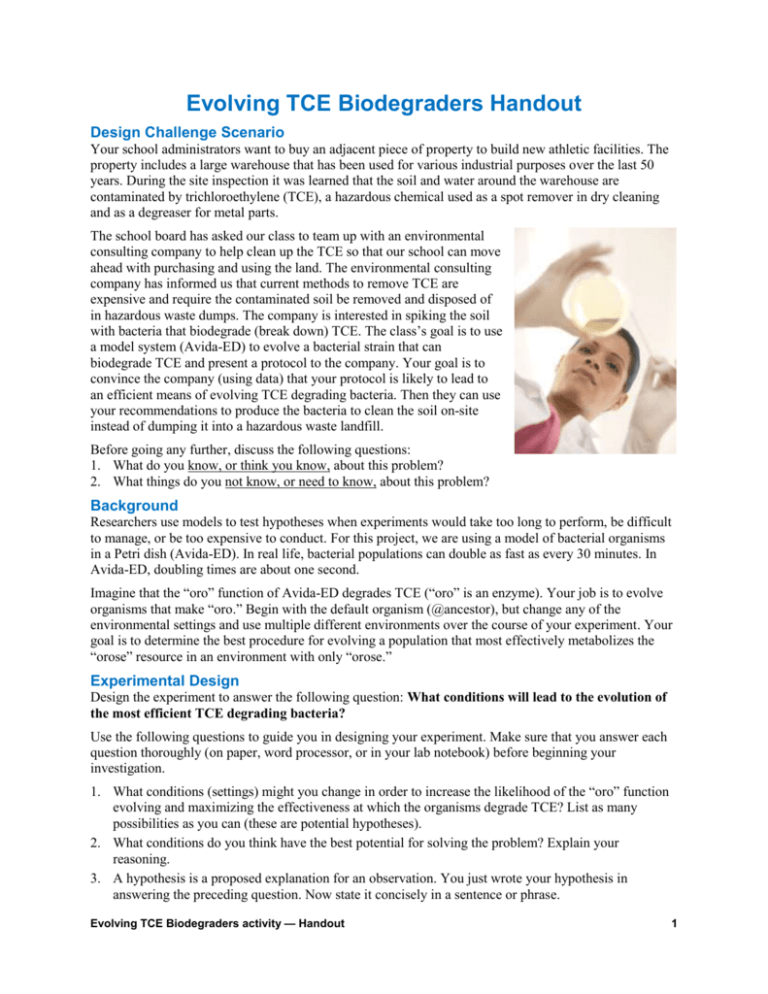
Evolving TCE Biodegraders Handout Design Challenge Scenario Your school administrators want to buy an adjacent piece of property to build new athletic facilities. The property includes a large warehouse that has been used for various industrial purposes over the last 50 years. During the site inspection it was learned that the soil and water around the warehouse are contaminated by trichloroethylene (TCE), a hazardous chemical used as a spot remover in dry cleaning and as a degreaser for metal parts. The school board has asked our class to team up with an environmental consulting company to help clean up the TCE so that our school can move ahead with purchasing and using the land. The environmental consulting company has informed us that current methods to remove TCE are expensive and require the contaminated soil be removed and disposed of in hazardous waste dumps. The company is interested in spiking the soil with bacteria that biodegrade (break down) TCE. The class’s goal is to use a model system (Avida-ED) to evolve a bacterial strain that can biodegrade TCE and present a protocol to the company. Your goal is to convince the company (using data) that your protocol is likely to lead to an efficient means of evolving TCE degrading bacteria. Then they can use your recommendations to produce the bacteria to clean the soil on-site instead of dumping it into a hazardous waste landfill. Before going any further, discuss the following questions: 1. What do you know, or think you know, about this problem? 2. What things do you not know, or need to know, about this problem? Background Researchers use models to test hypotheses when experiments would take too long to perform, be difficult to manage, or be too expensive to conduct. For this project, we are using a model of bacterial organisms in a Petri dish (Avida-ED). In real life, bacterial populations can double as fast as every 30 minutes. In Avida-ED, doubling times are about one second. Imagine that the “oro” function of Avida-ED degrades TCE (“oro” is an enzyme). Your job is to evolve organisms that make “oro.” Begin with the default organism (@ancestor), but change any of the environmental settings and use multiple different environments over the course of your experiment. Your goal is to determine the best procedure for evolving a population that most effectively metabolizes the “orose” resource in an environment with only “orose.” Experimental Design Design the experiment to answer the following question: What conditions will lead to the evolution of the most efficient TCE degrading bacteria? Use the following questions to guide you in designing your experiment. Make sure that you answer each question thoroughly (on paper, word processor, or in your lab notebook) before beginning your investigation. 1. What conditions (settings) might you change in order to increase the likelihood of the “oro” function evolving and maximizing the effectiveness at which the organisms degrade TCE? List as many possibilities as you can (these are potential hypotheses). 2. What conditions do you think have the best potential for solving the problem? Explain your reasoning. 3. A hypothesis is a proposed explanation for an observation. You just wrote your hypothesis in answering the preceding question. Now state it concisely in a sentence or phrase. Evolving TCE Biodegraders activity — Handout 1 4. Hypotheses lead to predictions. Based on your hypothesis about the best conditions for evolving efficient TCE degrading bacteria, your prediction is that the organisms will have a high fitness value in an environment with only the “orose” resource. Now state your hypothesis and your prediction together in an “if… then… “ statement in which the “if” refers to the hypothesis and the “then” refers to the results that you predict to observe. Make this a single sentence that concisely links your hypothesis (the “why”) to the prediction (the “what”) that follows the “if… then…” format. 5. What data do you need to collect in order to test your hypothesis? 6. How many data points (number of replications, variables, etc.) do you need to be able to confidently support or reject your hypothesis? Avida-ED is an instance of evolution in a model environment, which means that every run is unique. To draw any conclusions, you must include at least five runs for each treatment. 7. Describe your experimental design. Make this a concise description of your methods (including settings, replications, data collection, etc.) that is clear enough for another group to replicate. 8. What are the dependent and independent variables and the controls? When determining what variables need to be controlled for, it is often helpful to go back to the alternative possible explanations to your original question and think of how to specifically rule those out in your procedure. Another type of control that is often essential is a point of comparison (a “no treatment” group). 9. How will you organize your data as you collect it? Make a data table to fill in during the investigation. 10. How will you present the data? Usually this is a graph or series of graphs. What type of graph will best display the pattern that you expect to show? What are the x (independent variable) and y (dependent variable) axes of the graph? It may be helpful to sketch a quick version of the graph that you expect to see if your prediction is correct (later, you can compare your actual data to this to see if it is consistent). Data Collection For each run, write down the parameters you changed, the number of updates it took to evolve the “oro” function, what proportion of the population performed the “oro” function, and the maximum fitness values. During and after each run, record observations that you think might be important, but that are not included in the experimental design. Use these observations to help you explain the results. Data Analysis Display your results as graphs. Make sure to title each graph and label the axes. Conclusion Write a description of how your results support or refute the hypothesis. Proposal Based on the results of your investigation propose a protocol for evolving bacteria to degrade TCE. Prepare a brief presentation to the class to explain your proposal. Discussion As a class, evaluate the proposals and determine which protocol most effectively evolves efficient TCE degrading bacteria. Are there any unanswered questions? Your class may find that you have a protocol that you feel confident submitting to the environmental consulting company or you may decide that you need to run more experiments before doing so. It is important that you present data in support of your protocol in order to convince them that your protocol is likely to lead to a feasible plan for evolving TCE degrading bacteria. Evolving TCE Biodegraders activity — Handout 2
